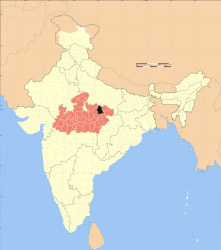Satna (District)
| Satna District ( Hindi सतना जिला ) |
|
|---|---|

|
|
| State | Madhya Pradesh |
| Division : | Satna |
| Administrative headquarters : | Satna |
| Area : | 7,502 km² |
| Residents : | 2,228,619 (2011) |
| Population density : | 297 inhabitants / km² |
| Website : | satna.nic.in |
The district of Satna ( Hindi सतना Distr ) is a district of the Indian state of Madhya Pradesh . The economic and administrative center is the city of Satna, with a population of around 300,000 .
geography
The Satna district is located in the northeast of the state of Madhya Pradesh and borders on Uttar Pradesh . The Tamsa River flows through it in a south-west-north-east direction . Neighboring districts are Panna District in the northwest , Katni District in the southwest , Umaria District in the south, Shahdol District in the southeast , Rewa District in the east and Banda District in the north and northeast (U.P.).
The average height above sea level is between 200 and 450 meters. Maximum heights of over 600 m are reached in the foothills of the Vindhya Mountains in the west and north-west.
Administrative division
The Satna District is divided into four administrative districts ( Tehsils or Subdivisions ): Amarpatan, Maihar, Nagod and Raghuraj Nagar; it consists of about 200 larger villages and only four or five large or medium-sized cities - Satna (approx. 300,000 inhabitants), Amarpatan (approx. 17,000 inhabitants), Maihar (approx. 40,000 inhabitants), Nagod (approx. 25,000 inhabitants) and Rampur (approx.12,000 inhabitants).
population
In the decade between 2001 and 2011, the population grew by around 19% to over 2.2 million, with the male population exceeding that of the female population by around 10%. About 78% of the population lives in rural villages; a quarter of the people are considered illiterate. They speak Hindi and the local dialect Bagheli .
economy
According to official statistics, the district of Panna is one of the 250 most backward districts in India, which is divided into 640 districts. It is very largely agricultural; only in the town of Satna, which has a train station, are there secondary schools, banks, hospitals and some larger shops and handicraft businesses.
history
The area around Satna belonged to the Gupta Empire from the 4th to 6th centuries and later to the Bagelkhand region , an offshoot of the Solanki Empire of Gujarat , which was repeated from the 13th to the 16th centuries by the Sultanate of Delhi , the Lodi -Dynasty and the Mughal Empire . The area was officially under British control since 1844 . After India's independence (1947), Satna belonged to the Union of Princely States of Vindhya Pradesh , which was dissolved in 1956 and integrated into the state of Madhya Pradesh, which consisted of the central provinces and Madhya Bharat , but was completely reorganized at the time.
Attractions
The Satna district, which is hardly developed for tourism, has several culturally and historically significant Gupta temples ( Nachna , Bhumara, etc.); The stump of the largely destroyed Buddhist stupa of Bharhut, including a small museum, is also located here. The three sites are only about 15 to 20 km south and south-west of Satna, but not easy to reach - a local driver or guide is therefore recommended. The Ramghat pilgrimage site on the Mandakini River near Chitrakoot is one of the most important in Madhya Pradesh; Rama , Lakshmana and Sita are said to have bathed here.
Web links
- Satna district - Census 2011 (English)
- District of Satna - Census 2011 etc. (English)
- Satna district - cards, administration, etc. (English)
Small text

